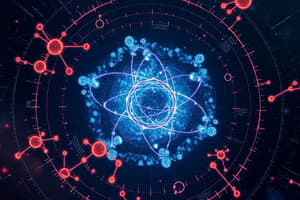Podcast
Questions and Answers
What accurately defines atomic radius?
What accurately defines atomic radius?
- The distance from the nucleus to the ionization energy level.
- Half the distance between the nuclei of two atoms joined by a single covalent bond. (correct)
- The average distance between the nucleus and the outermost electron.
- The total distance from the nucleus to the electron cloud.
Which factors contribute to the decrease in atomic radius across a period?
Which factors contribute to the decrease in atomic radius across a period?
- Increased nuclear charge and the same screening effect. (correct)
- Decreased screening effect and increased ionization energy.
- Increased atomic mass and decreased electron shielding.
- Decreased nuclear charge and increased atomic size.
What reasons chiefly explain the increase in atomic radius down a group?
What reasons chiefly explain the increase in atomic radius down a group?
- Extra energy levels, increased screening, and offsetting nuclear charge. (correct)
- Higher ionization energy and reduced nuclear attraction.
- Decreased electronegativity and increased effective nuclear charge.
- Increased nuclear size and stronger bonding forces.
Which description most accurately defines 1st ionisation energy?
Which description most accurately defines 1st ionisation energy?
What are the main reasons for the increase in 1st ionisation energy across a period?
What are the main reasons for the increase in 1st ionisation energy across a period?
Which combination leads to a decrease in 1st ionisation energy down a group?
Which combination leads to a decrease in 1st ionisation energy down a group?
What is the effect of increasing atomic radius on electronegativity trends down a group?
What is the effect of increasing atomic radius on electronegativity trends down a group?
What is the relationship between 1st ionisation energy and atomic radius across a period?
What is the relationship between 1st ionisation energy and atomic radius across a period?
How does increased nuclear charge across a period impact electronegativity?
How does increased nuclear charge across a period impact electronegativity?
Which of the following is the proper definition of electronegativity?
Which of the following is the proper definition of electronegativity?
Flashcards are hidden until you start studying
Study Notes
Atomic Radius
- Defined as half the distance between the nuclei of two atoms of the same element bonded by a single covalent bond.
- Decreases across a period due to increased nuclear charge and minimal effect of the screening effect.
- Increases down a group due to extra energy levels, increased screening, and offsetting the increase in nuclear charge.
Electronegativity
- Defined as the relative attraction that an element's nucleus has on shared electrons in a covalent bond.
- Increases across a period due to higher nuclear charge and smaller atomic radius, making atoms more attractive to electrons.
- Decreases down a group because the increased atomic radius decreases attraction to shared electrons.
Ionisation Energy
- 1st ionisation energy is the minimum energy needed to remove the most loosely bound electron from 1 mole of gaseous atoms in the ground state.
- Increases across a period owing to increased nuclear charge and decreased atomic radius.
- Decreases down a group due to increased atomic radius and increased screening effect.
Second Ionisation Energy
- Defined as the minimum energy required to remove the most loosely bound electron from a singly charged positive ion.
Reactivity
- Reactivity increases down a group as outermost electrons are further from the nucleus, making them less tightly held and easier to bond with other atoms.
Ionisation Energy Trends
- Large jumps between ionisation energies indicate the presence of distinct energy levels within an atom.
- The relationship between 1st ionisation energy and atomic radius within a period shows that as atomic radius decreases, 1st ionisation energy increases.
Influences on Trends
- Increased nuclear charge across a period enhances electronegativity by making the nucleus more attractive to electrons, enhancing bonding capabilities.
Studying That Suits You
Use AI to generate personalized quizzes and flashcards to suit your learning preferences.




